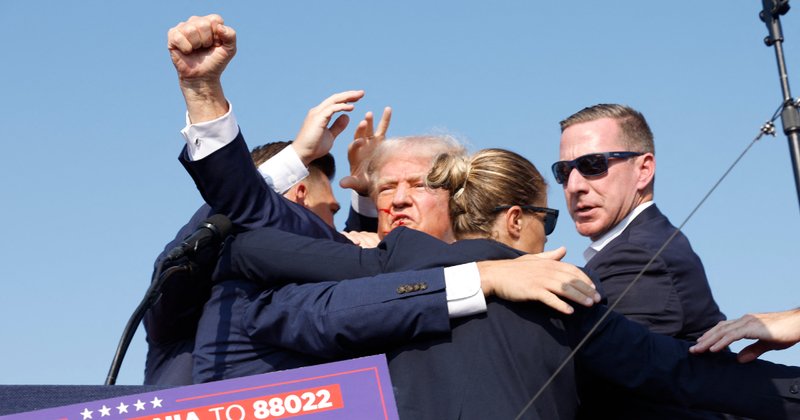Donald Trump shooting: false claims spread online after assassination attempt

After shots rang out at a Donald Trump rally in Pennsylvania on 13 July, social media became a hotbed for claims, counter-claims and conspiracy theories.
Images of a bloodied Donald Trump raising his fist would lead news coverage in the days after the attempted assassination attempt, which killed attendee Corey Comperatore. At the time of writing two others are in a serious condition.
The FBI named Thomas Matthew Crooks, 20, of Bethel Park, Pennsylvania, as the “subject involved”. He was shot dead at the scene.
World leaders including President Joe Biden and Prime Minister Keir Starmer were quick to condemn the attack on Mr Trump, which left him with a wound but no stitches to his right ear, according to his son Eric.
But online, many people were sharing their own theories as to what had occurred. We have fact checked several of these, and found them to be false—distorting real events, sometimes by using photo editing tools like Photoshop, and fabricating misleading narratives.
It’s not the first time that an act like this has become a magnet for conspiracy theories, for example President John F Kennedy’s assassination in 1963 spawned a raft of conspiracy theories, which continue to circulate today on social media.
Full Fact has written an in-depth report looking into why people believe conspiracy theories, which often circulate when shocking events occur.
Join 72,953 people who trust us to check the facts
Sign up to get weekly updates on politics, immigration, health and more.
Subscribe to weekly email newsletters from Full Fact for updates on politics, immigration, health and more. Our fact checks are free to read but not to produce, so you will also get occasional emails about fundraising and other ways you can help. You can unsubscribe at any time. For more information about how we use your data see our Privacy Policy.
‘Staged’ and manipulated images
While news and media organisations were just beginning to confirm the details of the shooting, a single word was trending on X (formerly known as Twitter) in the US and UK: “staged”.
Claims that it was a ‘false flag’ (an act carried out with the intention of blaming a political or military opponent for it) operation designed to increase support for Mr Trump ahead of the US presidential election in November racked up thousands of views.
The attack is being investigated by the FBI, and details about what exactly happened before the shooting continue to emerge. But we have seen no evidence to support the theories that it was staged.
Some online also shared two images of secret service agents surrounding the injured Mr Trump with broad smiles, with the implication that this showed the event had been faked.
One example was shared more than 6,600 times on X, and also appeared on Facebook and Threads with captions including: “Rehearsals” and “Why are the secret service smiling? STAGED”.
Another image features only Mr Trump and shows him smiling with a raised hand and his injured ear visible. Overlaid text says: “Think they bought it?”
But we found that the photographs had been digitally altered to change the expressions of the people featured from the two originals taken by an Associated Press photographer. In the many photographs and [WARNING: potentially distressing material] videos of the scene neither Mr Trump nor the secret service agents can be seen smiling.
Another picture was shared in the aftermath of the shooting with a claim it showed Mr Trump golfing the day after the attack. In the image the former president appeared to be in his trademark red “Make America Great Again” cap, swinging a golf club over his shoulder and with a small white bandage covering the top part of his ear.
But this picture wasn’t genuine either—the original was taken during a golf tournament in Miami in October 2022 and the bandage appears to have been digitally added.
Misidentified shooter
Although the shooter was named as a local young man the day after the incident, several names and images of other people have been widely shared, with competing claims they were responsible for the attack. Some continue to be circulated despite confirmation of Crooks’ involvement and subsequent death.
An Italian sports writer issued a statement denying any involvement in the shooting after an image of him, and an anglicised version of his name ‘Mark Violets’ was shared with claims he was the shooter.
We often see people being mistakenly identified as perpetrators or victims during significant news events such as this, and we have previously fact checked a number of claims which identified the wrong person in their aftermath.
During unfolding global events it’s essential to consider whether what you see online is accurate, so you can avoid sharing misleading information.
We have written a number of guides, including on how to spot misleading images and videos, and created a toolkit to help identify misinformation which can help you do this.